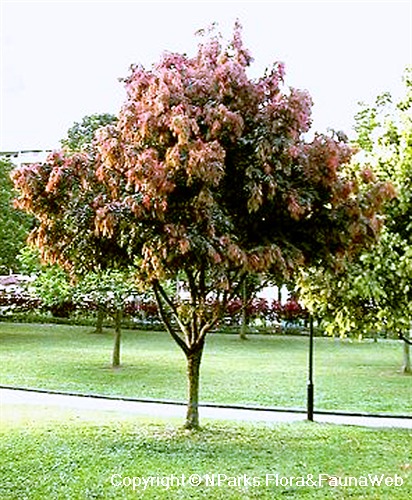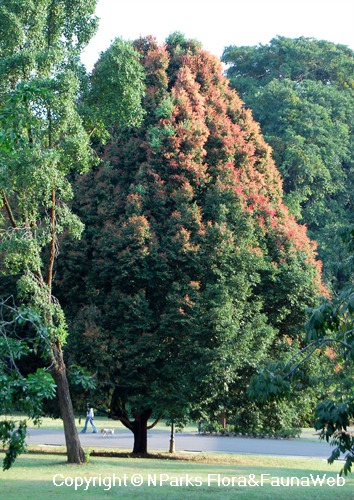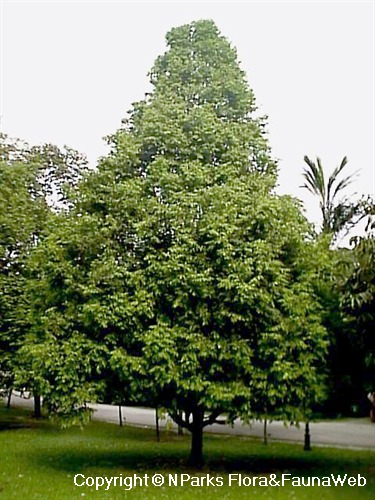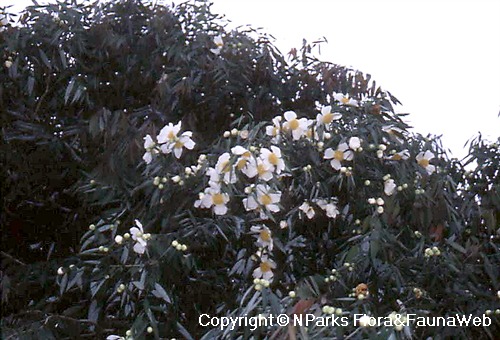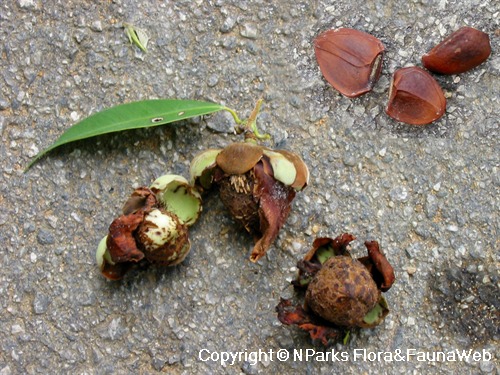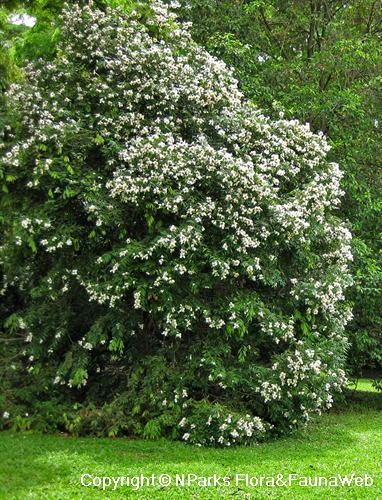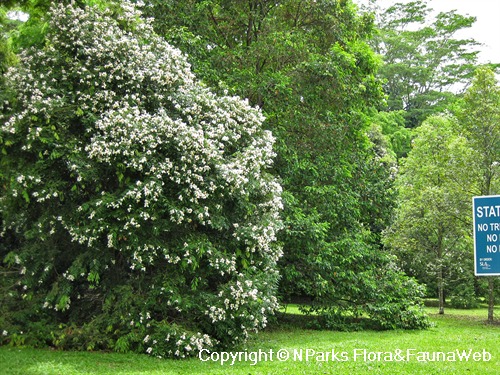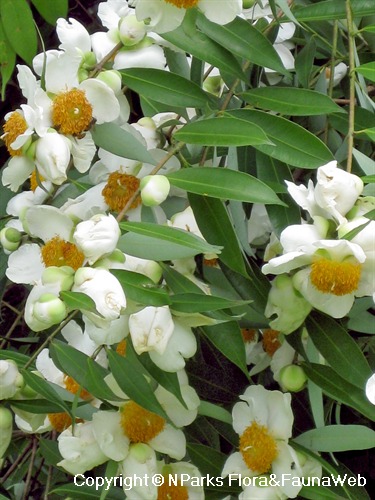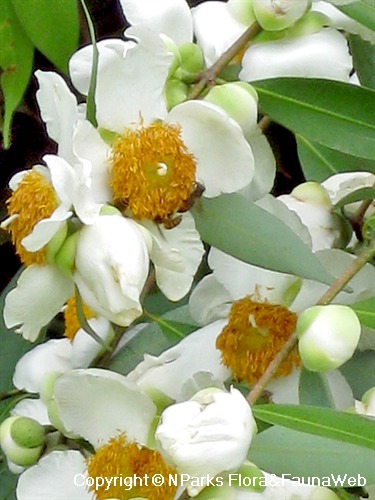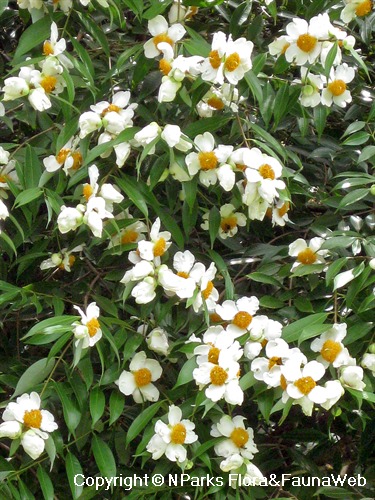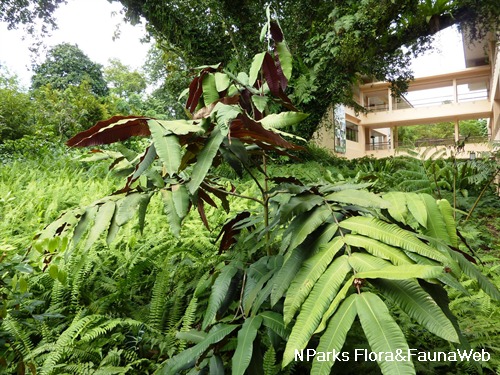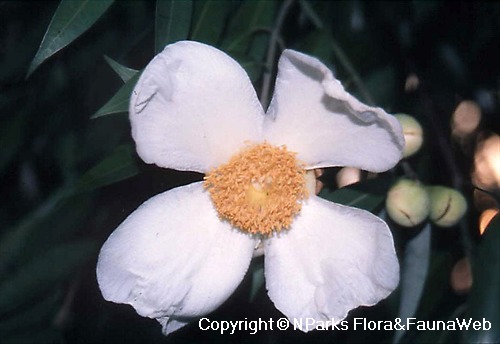
Back
Mesua ferrea L.
| Family Name: | Calophyllaceae |
| Synonyms: | Calophyllum nagassarium, Calophyllum pedunculata, Calophyllum nagassarium, Calophyllum speciosa, Calophyllum coromandeliana |
| Common Name: | Ceylon Ironwood, Na Tree, Diya Na, Nagchampa, Nagacuram, Nagasari, Ironwood Tree, Ironwood, Indian Rose Chestnut, Poached Egg Tree, Cobra's Saffron, Penaga Lilin, Penaga, Lenggapus, 铁力木, 铁木树 |
Mesua ferrea is a tree that can grow up to 30 meters tall. It produces white flowers with numerous yellow stamens. The wood is highly valued for its strength and durability, making it a preferred material for heavy construction, including railway sleepers and boat building.
Name
Classifications and Characteristics
| Plant Division | Angiosperms (Flowering Seed Plants) (Dicotyledon) |
|---|---|
| Plant Growth Form | Tree (Medium (16m-30m)) |
| Lifespan (in Singapore) | Perennial |
| Mode of Nutrition | Autotrophic |
| Plant Shape | Conical |
| Maximum Height | 18 m to 30 m |
| Maximum Plant Spread / Crown Width | 6 m to 12 m |
Biogeography
| Native Distribution | India, Sri Lanka, Nepal, Indochina, Peninsular Malaysia, Indonesia |
|---|---|
| Native Habitat | Terrestrial (Primary Rainforest, Monsoon Forest) |
| Preferred Climate Zone | Tropical, Sub-Tropical / Monsoonal |
Description and Ethnobotany
| Growth Form | Medium-sized tree, up to 30m tall in the wild, usually shorter under cultivation. Habit distinctly monopodial, with dense conical crown. Form is lanky under more constrained rainforest conditions, but tree grown in open space tends to retain its lower branches all the way to the ground, hence assuming a hedge-like appearance, where the trunk remains totally hidden. |
|---|---|
| Trunk | Slightly buttressed at base. Bark grey-reddish brown, shallowly-fissured, flaking in large irregular pieces, somewhat scented, and exuding aromatic white resin when bruised. |
| Foliage | Leaves pendulous, linear-lanceolate, with slightly scalloped margins. Mature leaves dark green above and with whitish waxy bloom below. Young leaves emerge purplish-red, hanging in limps tassels, maturing to yellowish-pink and then green. Flushing is especially prominent during the rainy period (March, September or October) that follows dry months.. |
| Flowers | Solitary, large (9cm across) and conspicuous, with 4 white fleshy petals surrounding a central core of yellow-orange filamentous stamens, very fragrant and bee-attracting. Flowers last only for 1 day, opening at 3-4am, becoming wide open at sunrise, and close 1 hour after sunset, while withered petals persist for a few more days. Blooming is seasonal, occurring mainly during dry weather (January to Feburary, June to August). Tree may burst into full bloom upon the onset of rain after a hot dry spell. |
| Fruit | Dehiscent valved ovoid capsule with woody sepals and numerous persistent basal filaments, ripening from green to brown. Seeds brown, irregularly-shaped, 1-4 per fruit. |
| Habitat | Moist lowland rainforests, associated with riverine sites. |
| Cultivation | Slow-growing, especially when young. Provide some shade at sapling stage, after which full sun is ideal. Prefers moist, well-drained soils. Easily propagated by seeds (75-90% germination rate), which should be sown as soon as possible, for they lose viability within 2-3 months. Cutitngs not preferred, as the resulting plants tend to lack a deep taproot. |
| Etymology | Genus epithet 'Mesua' named after Persian physician and medical author, John Mesue (Yuḥannā ibn Masawiah, 786-857 A.D.), who translated Greek medical writings into Arabic, upon the order of Caliph Harun al-Rashid who wanted to propagate ancient Greek medicine in the Islamic world. Mesue/ Masawiah's work sometimes wrongly attributed to his near-contemorary St. John of Damascus (Yuḥannā ibn Mansur, 676-749 A.D.), an Arab-Christian monk and church priest who served as chief administrator to the Caliph of Damascus -- because the first Latin translators of Mesue/ Masawiah's works wrongly rendered his last name as Mansur. Species epithet 'ferrea' derived from Latin term for iron, a reference to the tree's very heavy hardwood, which is so dense that it sinks in water even after being dried.Sanskrit-derived Malay name Penaga Lilin refers to the waxy bloom on the underside of leaves. Also commonly known as Na Tree or Diya Na in Sri Lanka, where Diya Na roughly transliterates to "water bathed", an apt reference to the tree's riverine habitat in the wild. In Singapore, sometimes mistakenly referred to as Sembawang Tree, but this instead refers to Mesua ferruginea (Ironwood Tree, a small riverine tree distributed across Southeast Asia. |
| Ethnobotanical Uses | Food (Herb or Spice) Others: Timber: Source of heavy hardwood (Penanga) with high density and durability similar to ebony, and dark reddish-brown heartwood. Used for heavy construction, railway sleepers, boat building, agricultural implements and tool handles. Trunks often used to make power transmission and telegraphic posts. Medicinal: Plant parts possess anti-inflammatory, anti-fungal, antibacterial, anti-hemorrhagic and anthelmintic (deworming) properties, traditionally used in Ayurvedic medicine. Seed kernel or flower stamens pounded with seed oil, and used as poultice for wounds and bleeding control. Seed oil also used to relieve skin itch, dandruff and rheumatism. Leaves used to treat fever, sore eyes and leprosy. Fresh flowers used to improve digestion and as cough remedy. Dried flowers used to treat bleeding hemorrhoids. In Malaysia and Java, decoction made from dried flowers given as tonic to women after childbirth. Roots said to be an antidote for poisonous snakebites. Products: Flowers used for their fragrance in perfumery (Nagchampa perfume), incense, cosmetics and soaps. Aromatic flower stamens once used to stuff pillows and cushions for bridal beds. Seeds yield up to 79% oil, which is extracted for lighting and perfumery. Culture: Regarded as highly-sacred in India, and declared as Sri Lanka's national tree in Feburary 1986. Oldest man-made forest in Sri Lanka is the 96-ha National Ironwood Forest, which consists of mainly Mesua ferrea descended from trees planted during King Dappula IV's reign in 8th century A.D. Buddhists believe that the next Buddha (Maitreya) will attain enlightenment under this tree, and Maitreya is traditionally depicted with a Mesua ferrea flower. Flowers given as offerings and seed oil used for lighting lamps in Buddhist temples. |
Landscaping Features
| Desirable Plant Features | Fragrant (Flowers) (Day), Ornamental Flowers, Ornamental Foliage |
|---|---|
| Landscape Uses | Suitable for Roadsides, General, Shade Providing Tree / Palm |
| Thematic Landscaping | Naturalistic Garden |
| Usage Hazard - Cons | Low Crown / Clearance |
Fauna, Pollination and Dispersal
| Pollination Method(s) | Biotic (Fauna) (Insects (Bee)) |
|---|---|
| Seed or Spore Dispersal | Abiotic (Explosive Dehiscence) |
Plant Care and Propagation
| Light Preference | Full Sun |
|---|---|
| Water Preference | Moderate Water |
| Plant Growth Rate | Slow |
| Rootzone Tolerance | Fertile Loamy Soils, Well-Drained Soils |
| Maintenance Requirements | Moderate |
| Propagation Method | Seed, Stem Cutting |
| Propagule Establishment Remarks | 75-90% seed germination success. Seeds need to sowed soon, as they lose viability within 2-3 months. |
| Propagation Method Remarks | Stem cuttings not preferred, as resulting trees lack taproot |
Foliar
| Foliage Retention | Evergreen |
|---|---|
| Mature Foliage Colour(s) | Green, Silver / Grey |
| Mature Foliage Texture(s) | Smooth |
| Prominent Young Flush Colour(s) | Red |
| Foliar Type | Simple / Unifoliate |
| Foliar Arrangement Along Stem | Opposite |
| Foliar Shape(s) | Non-Palm Foliage (Lanceolate) |
| Foliar Venation | Pinnate / Net |
| Foliar Margin | Entire |
| Foliar Apex - Tip | Acuminate |
| Foliar Base | Cuneate |
| Typical Foliar Area | Notophyll ( 20.25cm2 - 45 cm2 ) |
| Leaf Area Index (LAI) for Green Plot Ratio | 4.0 (Tree - Dense Canopy) |
Non - Foliar and Storage
| Trunk Type (Non Palm) | Woody |
|---|---|
| Bark Colour(s) | Reddish-brown |
| Mature Bark Texture | Fissured, Peeling / Flaking / Papery |
| Stem Type & Modification | Woody |
| Root Type | Underground (Tap Root, Fibrous Root), Aboveground (Buttress Root) |
Floral (Angiosperm)
| Flower & Plant Sexuality | Bisexual Flowers |
| Flower Colour(s) | White, Yellow / Golden |
|---|---|
| Flower Symmetry | Radial |
| Flower Size - Remarks | 9cm across |
| Ovary Position | Superior / Hypogynous |
| Flowering Period | Hot & Dry Period |
| Flowering Opening Time | Daytime |
| Flower Lifespan on Plant | 1 Day |
| Flowering Habit | Polycarpic |
Fruit, Seed and Spore
| Mature Fruit Colour(s) | Brown |
|---|---|
| Fruit Classification | Simple Fruit |
| Fruit Type | Dehiscent Dry Fruit , Capsule |
Image Repository
Others
| Master ID | 1730 |
|---|---|
| Species ID | 3023 |
| Flora Disclaimer | The information in this website has been compiled from reliable sources, such as reference works on medicinal plants. It is not a substitute for medical advice or treatment and NParks does not purport to provide any medical advice. Readers should always consult his/her physician before using or consuming a plant for medicinal purposes. |

